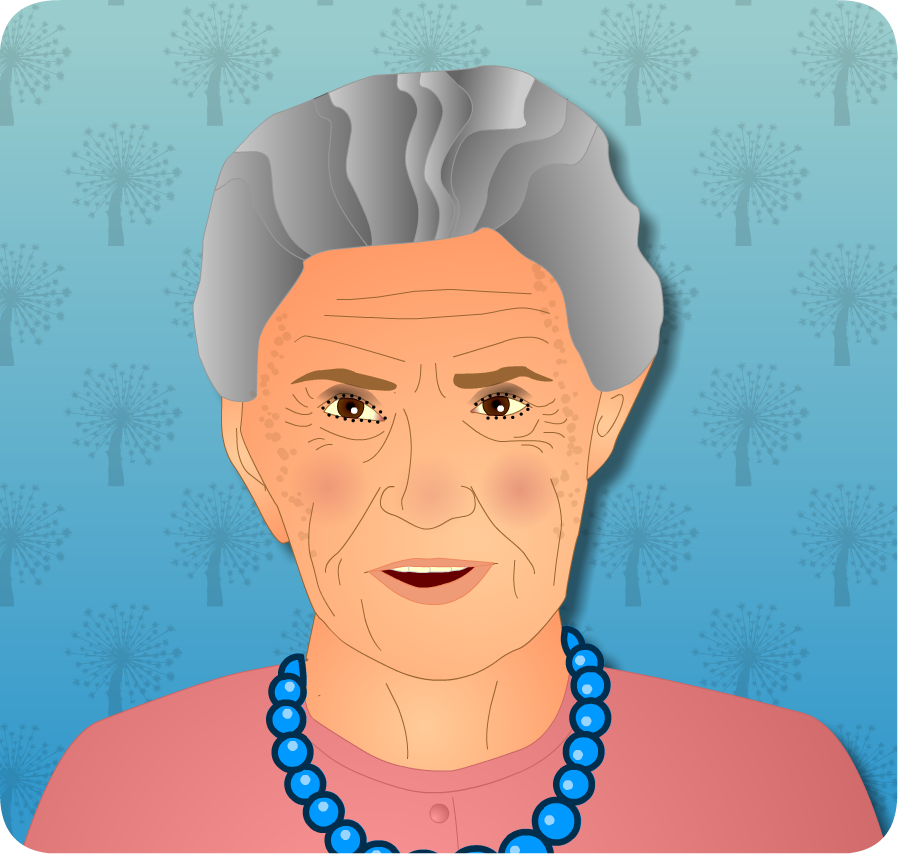- Wilma notices that her mother is now very reluctant to leave the house and makes excuses when she suggests going out somewhere.
- Wilma is concerned that her mother is becoming isolated and that she has not been meeting up with her friends at her local bingo club or church groups.
- Jennifer now relies on her neighbour to walk her dog Tipsy and appears reluctant to take back this responsibility.
- Even the visitors from the church have noticed a change in Jennifer’s mood.
- Wilma suggests that they speak to the physiotherapist to see if she can offer any help.
The physiotherapist visits Jennifer and Wilma at home and a discussion takes place regarding Jennifer’s concerns. Jennifer mentions that she is frightened she might fall and doesn’t like walking on her own. The physiotherapist tries to reassure Jennifer and asks her if it is OK to discuss this with the rest of the team. Jennifer agrees.
Initially Jennifer appears to be coping well at home. However, she tells her daughter that she is missing the “safe” environment of the hospital.
| Home Assessment Report |
| Patient Details |
Jennifer Parks, 10 Green Street, Edinburgh
DOB 10.10.30 |
| Social History |
Lives alone in ground-floor flat. Normally fully independent in personal and domestic tasks. Main interests include walking dog, attending bingo, church, and socialising with friends. Can be apprehensive in new situations. |
| Reason for Admission |
Right POC stroke resulting in homonymous hemianopia and visual inattention to her left side (resolving), residual balance problems (resolving). |
| Previous Medical History |
High blood pressure. |
| Present on Visit |
- Jennifer Parks (Patient)
- Wilma Parks(Daughter)
- Anne Brown (Occupational Therapist)
- Jane Black (Physiotherapist)
|
| Problem |
Recommendation |
Action (by whom) |
| Mrs Parks was generally well orientated around her flat and coped well with all activities. She appeared nervous transferring in/out of bath |
Bath-board and seat to be supplied (has been using this equipment effectively on the ward) |
Refer for equipment to be delivered prior to discharge planning.
Action Anne Brown – OT |
| Shopping – Still requiring physiotherapy input for out-door mobility (mainly confidence issues) |
Would benefit from accompanying person initially until confidence in outdoor mobility improves |
Daughter has agreed to accompany Mrs Parks Initially when home
Action Wilma Parks – Daughter, Referral to domiciliary physiotherapy – Jane Black |
| Patient living alone and expressing concerns about “getting help” in emergency |
Would benefit from personal alarm system |
Refer for personal alarm
Action – Anne Brown OT |
| Conclusion
Mrs Parks has made an excellent recovery since her stroke and is now fully independent in self care, including taking her medication and kitchen tasks. A mood screening tool has been carried out with no problems being identified from this. Although she was initially slightly worried about her ability to cope at home her fears were alleviated by the assessment as she achieved independence in most areas. The only area of concern highlighted on the assessment was transferring in/out of the bath. Equipment will be supplied which will improve her confidence (she has been using this equipment successfully on the ward).
She now feels more confident in her ability and is looking forward to returning home. Mrs Parks will be discharged home with follow-up domiciliary physiotherapy and regular visits from the stroke liaison nurse. |
The nursing staff discuss with Jennifer any other issues or concerns prior to her discharge. Although Jennifer was worried before her home assessment she now feels happy about returning home.
The MDT are happy with Jennifer’s progress and the occupational therapist therefore makes plans to carry out a home assessment. This will allow the team to assess how Jennifer copes in her own environment.
Jennifer’s CT scan shows a right POCS (See ‘Additional Information’ box below for further information).
On examination Jennifer is diagnosed with a left homonymous hemianopia with evidence of visual inattention to her left side. She has difficulty with her balance and therefore currently requires the assistance of one person to stand and two people to mobilise/walk.

 Jennifer Parks
Jennifer Parks
Jennifer is an 80 year old retired factory worker who lives alone in a ground floor flat.
Once indoors her rooms are on one level. Her daughter, Wilma, lives several miles away and has two school-age children. She works full time and as a result has limited time to assist her mother once discharged from hospital.
Jennifer was independent before being admitted to hospital on this occasion, however her daughter does suggest she can be a worrier in “new situations”. Jennifer’s main hobbies are bingo, walking her dog, and she is an active member of the local church.
The following contacts are not specific to stroke however may offer advice and support.
The following are possible signs of depression:
- Persistent low or sad mood. Low mood is consistently reported every day for 2 weeks
- Lack of interest in self, others or activities
- Lack of pleasure in activities
- Feeling hopeless about the future, e.g. unable to see themselves making any progress
- Changes in sleep pattern or appetite with no obvious organic cause
- Withdrawn/not attempting to initiate communication
- Avoiding certain situations or activities due to fears/anxieties
- Weepiness
- Lethargy/fatigue in excess of what can be expected post-stroke
- Increased irritability, angry outbursts, exaggerated sense of frustration
- Feelings of worthlessness
- Feelings of guilt
It is important to be aware that many of these signs may be present on their own, however, to diagnose depression formal assessment needs to be undertaken. To reach diagnostic criteria for depression five or more of the above symptoms must be present for at least 2 weeks (and are a change from the person’s usual state). One of the symptoms displayed must be either depressed mood or loss of interest/pleasure.



